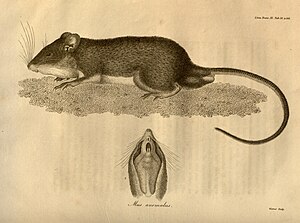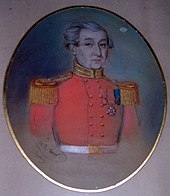Trinidad barbed pocket mouse
| Trinidad barbed pocket mouse | ||||||||||||
|---|---|---|---|---|---|---|---|---|---|---|---|---|

Trinidad Quarry Pocket Mouse ( Heteromys anomalus ) |
||||||||||||
| Systematics | ||||||||||||
|
||||||||||||
| Scientific name | ||||||||||||
| Heteromys anomalus | ||||||||||||
| ( Thompson , 1815) |
The Trinidad barbed pocket mouse ( Heteromys anomalus ) is a type of barbed pocket mouse . It occurs in several subspecies in northern South America in parts of Colombia and Venezuela as well as on the island of Trinidad .
features
The Trinidad barbed pocket mouse reaches an average head-trunk length of 13.4 centimeters for the males and 12.9 centimeters for the females. The tail becomes about 15.6 or 15.0 centimeters long. The ear length averages 19 millimeters and the hind foot length 34 millimeters. It is a medium-sized species within the genus and the males are usually slightly larger than the females. The fur of the adult animals is coarse and contains individual stiffened, spiky hairs on the back and on the sides of the body. The back fur is gray to gray-brown or pale brown in color and interspersed with darker spines and individual ocher-colored hairs. The belly side is white and is not separated from the back by a light side band. There is a dark, demarcated spot on the front legs.
The ears are comparatively large and rounded. The front areas of the soles of the hind feet are hairless. The slightly hairy tail is relatively long and significantly darker on the top than on the underside. The karyotype consists of 2n = 60 chromosomes (FN = 68).
From most of the other South American species of the genus, the Trinidad barbed pocket mouse is distinguished by its relatively large ears and pale, gray, and heavily speckled back fur, while the other species are generally darker, browner, and less speckled. The Gaumer barbed pocket mouse ( Heteromys gaumeri ) and the Paraguaná barbed pocket mouse ( Heteromys oasicus ) are smaller, in addition the Gaumer barbed pocket mouse has hairy soles and the Paraguaná barbed pocket mouse is paler in color and it lacks the dark colors for the front legs, Quill pocket mouse are typical.
distribution
The Trinidad barbed pocket mouse occurs in several subspecies in northern South America in parts of Colombia and Venezuela as well as on the islands of Isla Margarita and Trinidad . The altitude distribution extends to heights of around 1600 meters.
Way of life
The Trinidad barbed pocket mouse lives mainly in deciduous and rainforest areas of the South American Caribbean coast as well as in drier areas of the valley of the Río Magdalena in Colombia up to heights of 1600 meters. At the Macizco de Boconó in the Cordillera de Mérida , the species was even detected at an altitude of 2430 meters, together with numerous other species that live here at heights that are atypical for them. The animals live in moist to dry habitats and can be found in gallery forests of tropical savannas, scrubland, residual forests and also in secondary forest stands and shrubbery within agricultural areas, whereby they avoid the fields themselves.
The animals are nocturnal and live on the ground, but can also climb into bushes. They dig burrows with multiple entrances in the ground and feed primarily on seeds, fruits, green vegetation and insects. Like other species of the genus, they transport the collected food in their cheek pouches and bring them into their burrows. They are not very territorial and accept other individuals in their environment, the population density averages 2.2 individuals per hectare. The breeding season of the animals begins with the beginning of the rainy season. The young animals become independent after about 50 days and leave the mother's nest to build their own burrows.
Systematics
The Trinidad pocket mouse is classified as an independent species within the genus of the pocket mouse ( Heteromys ), which consists of 16 species. The first scientific description comes from the British naturalist John Vaughan Thompson from the year 1815, who introduced the species on the basis of individuals from the island of Trinidad as Mus anomalus as a species of mice . Thompson was a doctor and soldier, scientifically he was best known as a pioneer of cancerologists and early planktonologists . He described the Trinidad barbed pocket mouse as the first known species of barbed pocket mouse after a six-year stay in Trinidad . The French zoologist Anselme Gaëtan Desmarest first assigned the species to the hamster genus , Cricetus , in 1817 and then described the genus Heteromys in the same year on the basis of Mus anomalus , now Heteromys anomalus .
Together with the Aragua barbed-pocket mouse ( Heteromys catopterius ), the Paraguaná barbed-pocket mouse ( Heteromys oasicus ), the southern barbed-pocket mouse ( Heteromys australis ) and the Ecuador- barbed-pocket mouse ( Heteromys teleus ), it forms one of the species complexes designated as anomalus complex in South America occurring Heteromys species with the exception of the Desmarest barbed pocket mouse ( Heteromys desmarestianus ).
Within the species, four subspecies are distinguished together with the nominate form :
- Heteromys anomalus anomalus Thompson, 1815 : nominate form; The subspecies occurs in the north and east of Venezuela including Isla Margarita and on the island of Trinidad.
- Heteromys anomalus brachialis Osgood , 1912 : This form occurs in northwestern Venezuela east of Lake Maracaibo . Animals from a population in the Serraniá de Perijá in the Colombian-Venezuelan border region probably also belong to this subspecies.
- Heteromys anomalus hershkovitzi Hernández-Camack , 1968 : This form lives in west-central Colombia in the valley of the Río Magdalena and the adjacent mountain ranges of the Andes .
- Heteromys anomalus jesupi J.A. Allen , 1939 : This form lives in northern Colombia in the Sierra Nevada de Santa Marta up to an altitude of 610 meters.
Status, threat and protection
The Trinidad quill pocket mouse is classified by the International Union for Conservation of Nature and Natural Resources (IUCN) as "not endangered" (least concern). The habitats in the forest areas are in some cases decreasing, but the species is relatively adaptable and there are no known threats to its existence.
supporting documents
- ↑ a b c d e f g h i j k l m n Trinidad Spiny Pocket Mouse. In: David J. Hafner: Subfamily Heteromyoninae, Genus Heteromys. In: Don E. Wilson, TE Lacher, Jr., Russell A. Mittermeier (Eds.): Handbook of the Mammals of the World: Lagomorphs and Rodents 1. (HMW, Volume 6) Lynx Edicions, Barcelona 2016, p. 197 -198, ISBN 978-84-941892-3-4 .
- ↑ a b c Heteromys australis in the endangered Red List species the IUCN 2018 Posted by: RP Anderson, D. Tirira, R. Samudio, 2016. Retrieved on January 10 of 2019.
- ↑ a b c Heteromys (Heteromys) anomalus . In: Don E. Wilson , DeeAnn M. Reeder (Eds.): Mammal Species of the World. A taxonomic and geographic Reference. 2 volumes. 3. Edition. Johns Hopkins University Press, Baltimore MD 2005, ISBN 0-8018-8221-4 .
- ^ John Vaughan Thompson : Description of a new species of the genus Mus, belonging to the section of pouched rats. Transactions of the Linnean Society of London 11 (1), 1815; Pp. 161-163. ( Digitized version )
- ↑ David M. Damkaer: John Vaughan Thompson (1779-1847), Pioneer Planktonologist: A Life Renewed. Journal of Crustacean Biology 36 (2) March 1, 2016; Pp. 256-262. doi : 10.1163 / 1937240X-00002409
- ↑ a b R. P. Anderson: Caribbean Spiny Pocket Mouse. In: JL Patton, UFJ Pardiñas, G. D'Elía (Eds.): Mammals of South America, Volume 2: Rodents. University of Chicago Press, 2015; Pp. 53-54. ( Full text )
literature
- Trinidad Spiny Pocket Mouse. In: David J. Hafner: Subfamily Heteromyoninae, Genus Heteromys. In: Don E. Wilson, TE Lacher, Jr., Russell A. Mittermeier (Eds.): Handbook of the Mammals of the World: Lagomorphs and Rodents 1. (HMW, Volume 6) Lynx Edicions, Barcelona 2016, p. 197 -198, ISBN 978-84-941892-3-4 .
- RP Anderson: Caribbean Spiny Pocket Mouse. In: JL Patton, UFJ Pardiñas, G. D'Elía (Eds.): Mammals of South America, Volume 2: Rodents. University of Chicago Press, 2015; Pp. 53-54. ( Full text )
Web links
- Heteromys australis in the endangered Red List species the IUCN 2018 Posted by: RP Anderson, D. Tirira, R. Samudio, 2016. Retrieved on January 10 of 2019.
